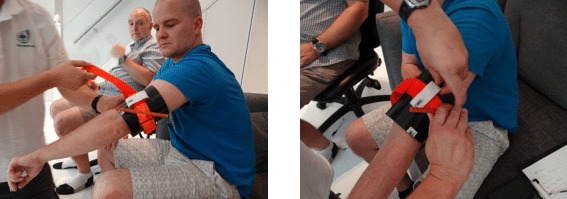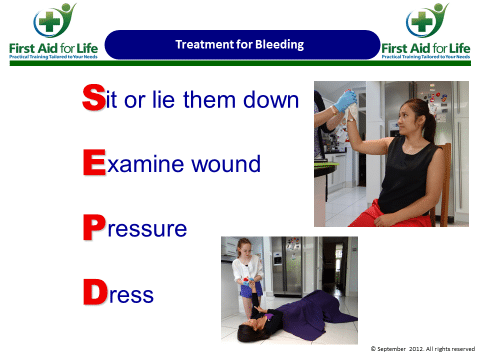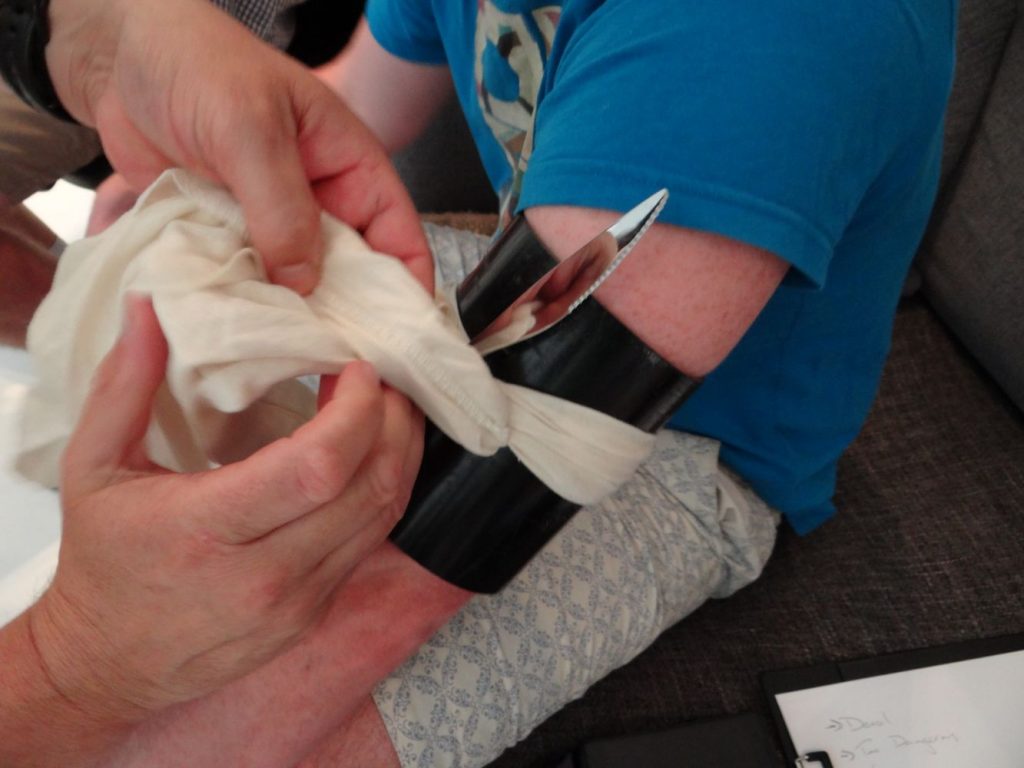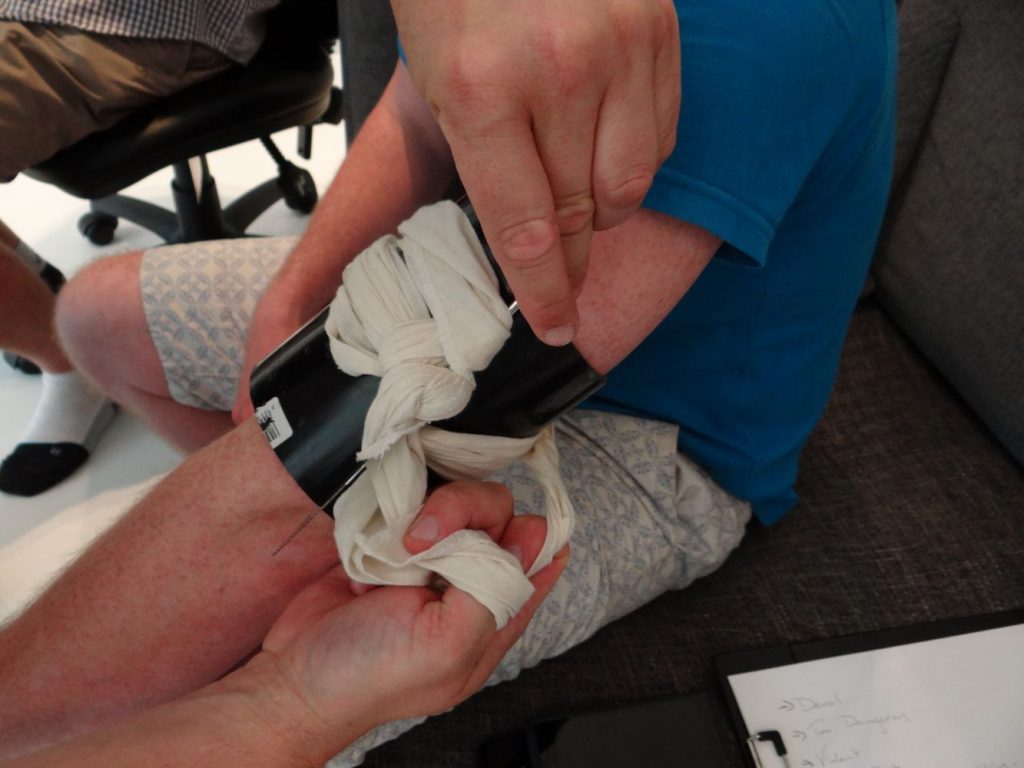How To Use A Tourniquet

The European Resuscitation Council (ERC) First Assist Guidelines 2015 country that when direct pressure cannot control severe bleeding, tourniquets and haemostatic dressings are now advised. ILCOR (International Liaison Committee on Resuscitation) fully supports this
If someone is bleeding extremely heavily from either a major artery or vein, they tin apace lose a lot of claret. The bleeding is likely to pulsate in time with the heart. This is more pronounced with an arterial drain, but happens inside venous bleeds too. With extremely heavy, potentially catastrophic bleeding an developed could easily lose twoscore% of their blood volume in 3-4 minutes. This could exist even quicker when dealing with children.
If a prey loses a substantial amount of blood – more than forty% of their blood book, the body is no longer able to compensate for that amount of blood loss. They will develop hypovolaemic shock. Hypovolaemic stupor is a low volume of claret causing failure of the circulatory organization, if untreated they volition die.
Armed services and civilian research has shown wealth of show demonstrating the effectiveness of tourniquets and haemostatic dressings in the handling of life-threatening bleeding.
Primal changes in the new European Resuscitation Guidelines relating to bleeding:
- New guidelines no longer recommend elevation for the control of severe bleeding. Elevation does reduce the flow of blood, merely alone it will not finish bleeding. If someone has an arterial bleed, just holding information technology in the air is non going to terminate the haemorrhage. Applying direct pressure level to the source of bleeding is much more than likely to cease life-threatening claret flow.
- You should not utilise indirect pressure level points to command severe bleeding. There is more than than one avenue supplying the claret to each limb. Pressing on pressure points will not be able to end the blood period. Finding pressure points can also be very difficult, especially with the femoral artery.
Click here for a Street Crime First Help course including catastrophic bleeding and tourniquets
Treatment of Bleeding:

- Encourage the casualty to sit or lie down in the almost appropriate position for the location of the wound and the amount of blood lost. If they are feeling light-headed and showing early on signs of shock, heighten their legs.
- Examine the wound (as quickly every bit possible) to assess:
- The type and extent of bleeding.
- The source of the bleeding.
- Whether at that place are any foreign objects embedded in the wound – if so, do non remove them as they will be stemming haemorrhage, but apply direct pressure level either side of the object.
- Apply straight force per unit area to try and command bleeding. If you command the bleeding with this directly force per unit area, keep holding for x minutes equally information technology takes this long for clots to form.
- Once you control bleeding, dress the wound – if the wound bleeds through the showtime dressing, apply another on top. If the wound bleeds through the second dressing you should consider alternative options to cease the bleeding.
The beginning step when treating a catastrophic bleed is always to utilise direct force per unit area. It is nevertheless likely to exist the get-go and only solution needed for the casualty.
Please note:
Tourniquets and haemostatic dressings take been introduced every bit boosted options to treat astringent catastrophic bleeding. However, straight pressure remains the master choice of treatment and it will control bleeding in the vast majority of cases. The European Resuscitation Quango 2015 guidelines state that haemostatic dressings and tourniquets should be used when direct pressure level is either not possible or ineffective.
In environments where a catastrophic bleed is likely, tourniquets and haemostatic dressings should be an integral part of the beginning aid kit. All showtime aiders should be trained in their employ.
As a fellow member of the full general public you lot are highly unlikely to demand to utilise a tourniquet. However understanding how to improvise ane, and how and when to employ one, could salvage lives if you're e'er involved in a major medical blow or emergency.
Do Improvised Tourniquets Work?
At that place is ongoing debate around the usefulness of an improvised tourniquet: Stewart SK, Duchesne JC, Khan MA discussed this in their paper – Improvised Tourniquets: obsolete or obligatory: Journal of Trauma Acute Care Surg 2014;78;1. He came to the following determination:
"We propose that pedagogy on how to expertly construct and employ an improvised tourniquet becomes and integral part of basic life support and pre-hospital emergency care algorithms, for military and civilians alike. In the absence of a commercially produced tourniquet, this uncomplicated first aid measure can satisfactorily arrest life-threatening haemorrhage, while minimizing morbidity that other cruder designs may cause."
How to Use an Improvised Tourniquet
Hither is one of the easiest means to make an improvised tourniquet from the contents of a standard get-go aid kit. Apply a triangular bandage folded into a wide fold bandage and to tighten the tourniquet using scissors equally a windlass. If y'all have access to cutlery, such every bit a table knife, this would be fifty-fifty better. Otherwise you no longer take your pair of scissors available to use.
Please notation: A tourniquet should be at least 4cm wide to prevent localised damage to nerve tissues.
- Tie the bandage around the blank limb on a single bone (i.e. if the lower role of the arm or leg are bleeding, you lot should tie the tourniquet on the upper office, where there is only one os rather than two).
- The tourniquet should be at to the lowest degree 5cm in a higher place the wound, or 5cm above the joint if the wound is on the lower limb. Never identify a tourniquet over a joint.
If there'due south a clean cutting through an artery, for example in a deep incised wound, the artery can contract back upwards the arm or leg. This is why you should place the tourniquet at to the lowest degree 5cm (or 2 inches) to a higher place the wound.
You may find other guidance on the positioning of a tourniquet, such as applying the commencement tourniquet mid-point over a single bone. This advice is also acceptable, then long as the tourniquet is positioned proximal to the wound (closer to the body of the body).
Interested in a Street Crime Commencement Help grade including catastrophic bleeding and tourniquets? Click here
1. Identify the pocketknife or your scissors on top of the knot and tie another knot on summit of them.

2. Utilize the knife or your scissors equally a windlass to wind round and tighten the tourniquet.

3. The windlass tin be secured either by tying another triangular bandage to stop it unwinding or by wrapping and tying both ends of the triangular bandage effectually the ends of the windlass to ensure it remains in place.

Fourth dimension Factor
It is of import to notation the exact fourth dimension in which y'all applied the tourniquet. To adjust for urgent transfer for medical assist, ensure yous tell them where and when the tourniquet was applied.
Please note it volition be extremely painful for the casualty to have a tourniquet. Howewver information technology is absolutely vital that you utilise the tourniquet tight plenty to entirely stop the bleeding.
If a tourniquet is non on tight enough it tin brand things worse as information technology can occlude the veins. Arteries may be harder to stop as they are less easy to get to. Moreover, if the venous return is stopped past the tourniquet, the just identify for blood to come out is from the wound.
NEVER exist tempted to loosen or remove a tourniquet. Once applied, tourniquets should only ever be removed past a doctor in a hospital setting.
Unsuitable but Tempting Alternatives for an Improvised Tourniquet:
A tie is likely to be too thin. A leather belt is too unsuitable as it is too tough to utilise with a windlass; you lot will be unable to provide sufficient force by paw to tighten it sufficiently to provide enough pressure to stop the claret flow.
A tourniquet should be at least 4cm wide to prevent localised harm to nerves tissues.
A tourniquet must be put on sufficiently tight to stop the bleeding. If it is non tight enough it can actually end upwards increasing blood loss. It may exist necessary to employ more one tourniquet to completely finish haemorrhage.
It is important for the doctor treating the casualty to have a proficient understanding of how long the tourniquet has been practical for. Write the time the tourniquet was applied onto the tourniquet itself or onto the casualty.
Please think that although tourniquets tin relieve lives, their use should not be taken lightly. They remain a second-line treatment when direct pressure is not possible or insufficient to command bleeding.

About us
Commencement Aid for Life provide accolade-winning first aid grooming tailored to your needs. Delight visit our site and learn more than almost our practical and online courses. It is vital to go along your skills current and refreshed. We are currently providing essential preparation for individuals and groups across the UK. In addition, we have a great range of online courses. These are platonic as refreshers for regulated qualifications or equally Appointed Person qualifications.
You can attend a fully regulated Practical or Online First Assistance form to empathise what to do in a medical emergency. Please visit https://firstaidforlife.org.united kingdom or call 0208 675 4036 for more information well-nigh our courses.
Outset Aid for Life is a multi-award-winning, fully regulated first aid training provider. Our trainers are highly experienced medical, health and emergency services professionals who volition tailor the grooming to your needs. Courses for groups or individuals at our venue or yours.
First Assistance for life provides this information for guidance and it is not in any fashion a substitute for medical advice. We are not responsible or liable for whatsoever diagnosis made, or actions taken on this information.
How To Use A Tourniquet,
Source: https://firstaidforlife.org.uk/tourniquets/
Posted by: smithmanneve.blogspot.com


0 Response to "How To Use A Tourniquet"
Post a Comment